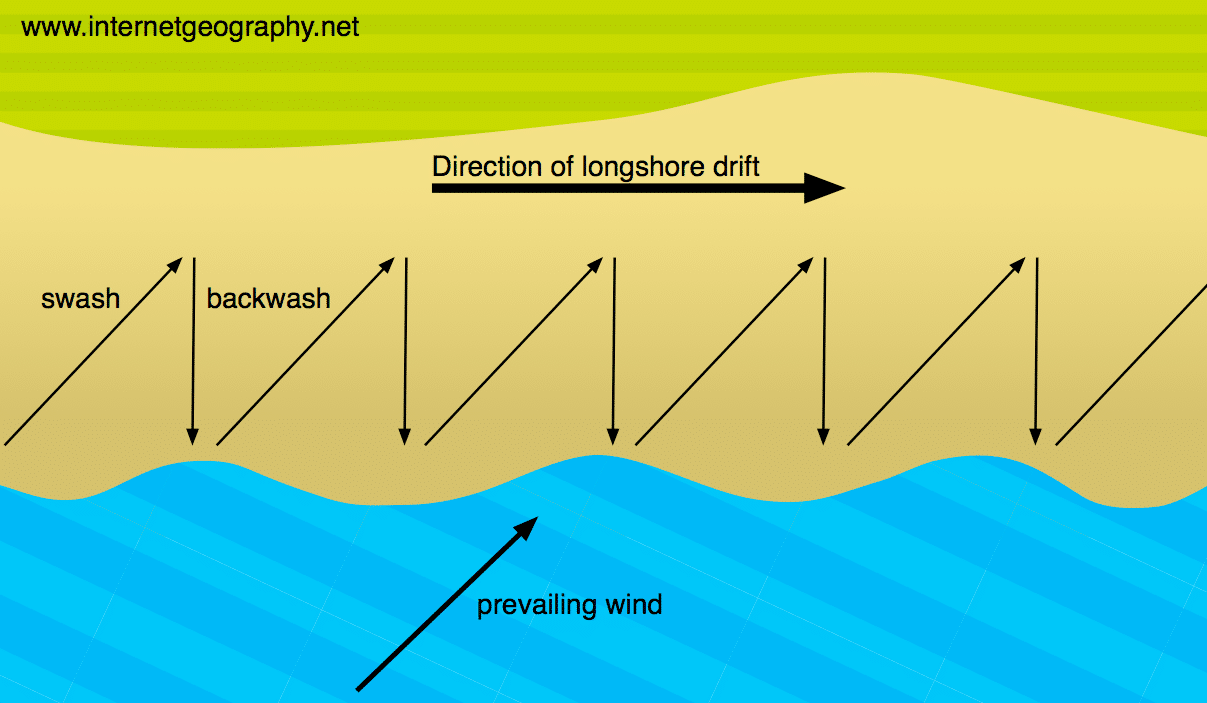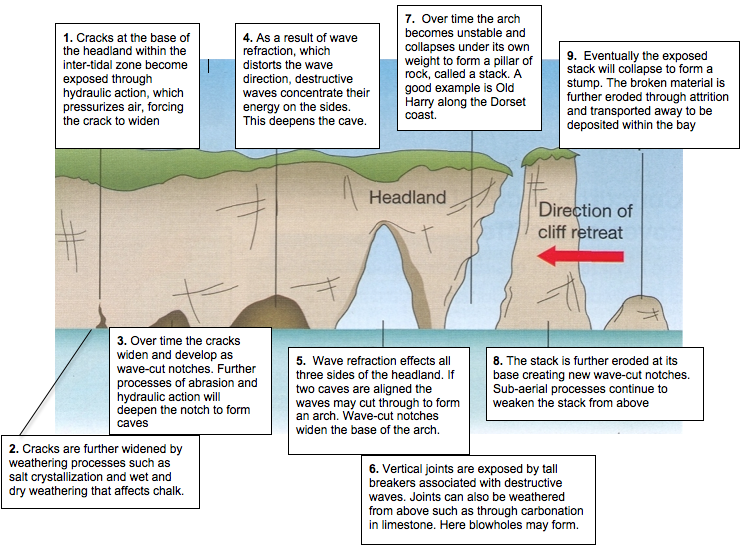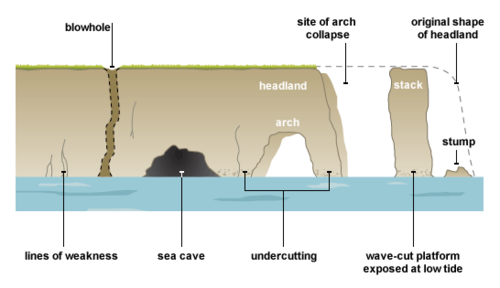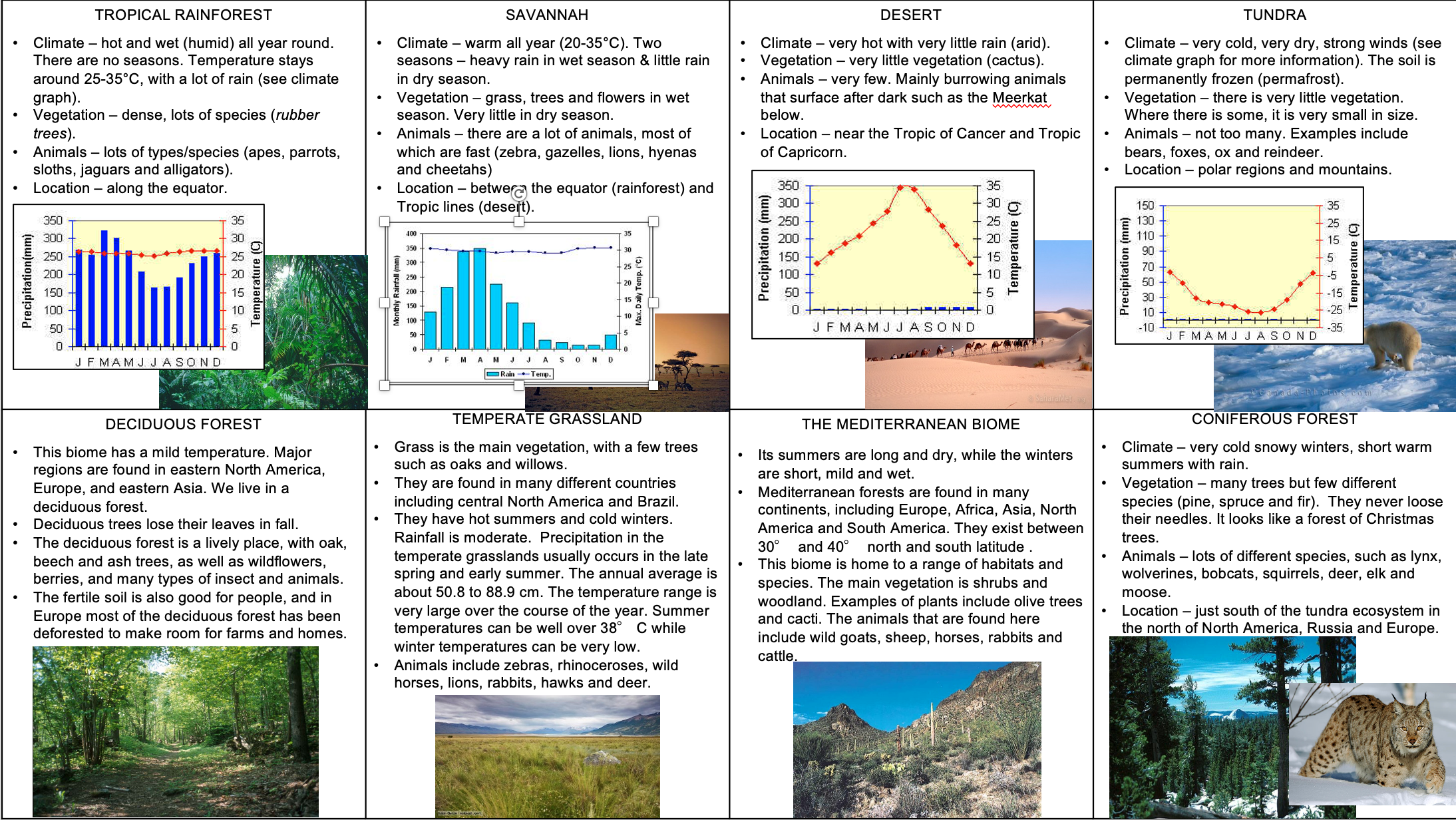
Year 9 - Geography Revision
1. Coastal landscapes and processes
What is the ‘coast’?
How are coastal areas used by humans?
What is longshore drift?
How does longshore drift happen?
What are some examples of hard engineering costal management strategies?
What are the benefits/advantages of hard engineering costal management strategies?
What are the coastal landforms created by erosion?
How are erosional coastal landforms created?
2.The Living world: ecosystems
What is the role of producers, consumers and decomposers in a food chain
Numerical skills (E.g mean, median, range)
What are the worlds biomes like? (E.g climate, vegetation, animals)
What are the tropical rainforests like? (E.g climate, vegetation, animals)
How are animals and plants adapted to living in hot desserts?
How are animals and plants adapted to living in tundra?
Coastal landscapes and processes
What is the ‘coast’? T he ‘coast' is the area where land meets the sea
How are coastal areas used by humans? Use of coastal areas: Tourism, Trade, Fishing, Settlement, Leisure/recreation, educational research/study
What is longshore drift? Long shore drift is the movement of material/sediment a long the beach by waves.
How does longshore drift happen? The process of Long shore drift occurs in a zig zag pattern
 process:
process:
Waves hit the beach at an angle
The SWASH carries the material up at an angle
The BACKWASH returns the material back to the sea at a 90 degree angle
This process repeats itself and transports the material a long the beach in a zig zag pattern
What are some examples of hard engineering costal management strategies?
Hard engineering (Man made) | Soft engineering (Natural) |
|---|---|
Groynes | Salt Marsh |
Sea Wall | Beach Nourishment |
Rock Armour | Do nothing |
What are the benefits/advantages of hard engineering costal management strategies? Take Groynes and Sea Walls as an example.
Benefits of Groynes include :
builds up the by trapping sediment
acts as a natural barrier to erosion and attracts tourists
relatively cheap as most of them are made up of wood
relatively long lasting
Cheaper to repair than other hand engineering strategies.
Benefits of Sea Walls include :
sea walls often have a promenade on top of them which are popular with tourists
sea walls tend to have a long life - span and provide excellent defence where wave energy is large
Sea walls do not impede the movement of sediment along the coast by longshore drift.
What are the coastal landforms created by erosion? Landforms created by erosion include headlands and bays, caves, arches, stacks and stumps. Headlands are usually formed of more resistant rock types than bays.If there are different bands of rock along a coastline, the weaker or softer rock, such as clay, is eroded fastest. This leaves more resistant rock types, such as granite, sticking out.
Additional info : https://www.bbc.co.uk/bitesize/guides/zxj6fg8/revision/1

 How are erosional coastal landforms created? The coastline is constantly eroding. There are four key types of erosion:
How are erosional coastal landforms created? The coastline is constantly eroding. There are four key types of erosion:
Abrasion - waves transport material which hit the cliff and gradually wear it away.
Hydraulic action - as waves approach the coast they trap air and force it into gaps in the cliff. Eventually this weakens the rock.
Attrition - waves cause the rocks to crash against each other, breaking them down into smaller and rounder pieces.
Corrosion (also known as solution) - salts and acids in seawater dissolve the rock gradually over thousands of years.
Process:
Waves attack the base of the cliff. Hydraulic action puts pressure on the crack/fault in the headland, forcing the crack to widen into a cave.
Waves continue to attack the base of the cliff. Abrasion causes waves to throw large amounts of sediment at the cave, creating a sand-blasting effect, which causes large amounts of the cave to be eroded. This leads to the cave widening and breaking through to the other side of the headland, forming an arch.
Continued abrasion at the base and weathering at the top of the arch cause it to weaken, eventually leading to the top collapsing.
This leaves the headland on one side and an isolated pillar of rock known as a stack on the other.
PRACTICE QUESTIONS :
Explain two benefits of a hard engineering costal management strategies (4 marks)
P. One benefit of seawalls is that they have a long life-span/last a long time.
Ex. This is good because it means that the local government does not have to continuously repair and maintain the sea wall nor invest extra costs towards it.
P. Another benefit of sea walls is that they are an excellent defence against wave energy.
Ex. This is good because it means that there is good protection against infrastructure / roads and towns and coastal flooding.
The Living world: ecosystems
What is the role of producers, consumers and decomposers in a food chain? There are three main types of living things in an ecosystem: producers, consumers, and decomposers. Producers produce or make their own soil/food. Usually, they make their food from sunlight/interaction through photosynthesis. Without producers, no animals/plants would be able to survive. That’s because all animals are producers/consumers and need to consume or eat their food. Some animals, called herbivores, get their energy from eating plants. Other animals, called carnivores, get their energy from eating other carnivores/animals. The third group of animals are called omnivores. Omnivores get their energy by eating both/only plants and meat. Finally, there are decomposers. Decomposers consume living/dead plants and animals and break them down into nutrients that are released into the soil. These nutrients are used by producers like plants to help them rise/grow, and the cycle begins all over again.
Producers | Consumers | Decomposers |
|---|---|---|
Tree | Tiger | Fungi |
Flowers | Sheep | Worms |
Grass | Bear | Snail |
Numerical skills (E.g mean, median, range)
How to solve a median : List all your numbers from smallest to largest. E.g 4,2,8,1,15 → 1,2,4,8,15 then find out the middle number. In this case, it’s 4. If there are two middle numbers, add them together and divide by 2.
How to solve a mode : The mode is the number that occurs the most in a set of numbers. Check what number appears the most. E.g 2,4,5,5,4,5 → It’s 5 because it appears three times.
How to solve a mean: The mean (average) of a data set is found by adding all numbers in the data set and then dividing by the number of values in the set.
How to solve the range: subtract the biggest number by the smallest number
What are the worlds biomes like? (E.g climate, vegetation, animals)
 What are the tropical rainforests like? (E.g climate, vegetation, animals) Check above!
What are the tropical rainforests like? (E.g climate, vegetation, animals) Check above!
Additional info : https://earthobservatory.nasa.gov/biome/biorainforest.php (Extremely helpful for location, precipitation, animals and conditions)
How are animals and plants adapted to living in hot desserts? Hot deserts have an extreme climate and challenging environment. There is very little biodiversity in hot deserts because of the harsh climate. Few species are specialised enough to survive there. Plants and animals which do survive there have adapted to difficult conditions.
Adaptations of a camel | Adaptations of a cactus |
|---|---|
Thin fur across body to maximise heat loss and keep them cool. | Large trunk to store water during the long periods of droughts |
Can drink up to 46L in one session and can last very long periods without drinking water. | Spikes to stop animals or predators from attacking or stealing it’s supply |
Camels don’t sweat very often nor urine | Have long, shallow root system that sucks up the rain as rainstorms are infrequent |
They have large, wide, flat and webbed feet to keep stable on sand and stop sinking | Pleats on trunk that expand to store more water. Some cacti can store up to 5 tonnes of water |
Thick fur on the top of their bodies to provide shade during the day as it is extremely hot during the day | |
Large body size to have more space where heat can leave, and they can tolerate temperatures up to 42 degrees Celsius . | |
Large nostrils and long eyelashes to protect from sandstorms |
How are animals and plants adapted to living in tundra?
Many of them have larger bodies and shorter arms, legs and tails which helps them retain their heat better and prevent heat loss. Many of the birds of the tundra have two coats of feathers to help keep them warm.
Additional info : https://www.wilsoncsd.org/cms/lib/NY01914054/Centricity/Domain/162/tundra_plant_animal_adaptations.pdf
Year 9 - Geography Revision
1. Coastal landscapes and processes
What is the ‘coast’?
How are coastal areas used by humans?
What is longshore drift?
How does longshore drift happen?
What are some examples of hard engineering costal management strategies?
What are the benefits/advantages of hard engineering costal management strategies?
What are the coastal landforms created by erosion?
How are erosional coastal landforms created?
2.The Living world: ecosystems
What is the role of producers, consumers and decomposers in a food chain
Numerical skills (E.g mean, median, range)
What are the worlds biomes like? (E.g climate, vegetation, animals)
What are the tropical rainforests like? (E.g climate, vegetation, animals)
How are animals and plants adapted to living in hot desserts?
How are animals and plants adapted to living in tundra?
Coastal landscapes and processes
What is the ‘coast’? T he ‘coast' is the area where land meets the sea
How are coastal areas used by humans? Use of coastal areas: Tourism, Trade, Fishing, Settlement, Leisure/recreation, educational research/study
What is longshore drift? Long shore drift is the movement of material/sediment a long the beach by waves.
How does longshore drift happen? The process of Long shore drift occurs in a zig zag pattern
 process:
process:
Waves hit the beach at an angle
The SWASH carries the material up at an angle
The BACKWASH returns the material back to the sea at a 90 degree angle
This process repeats itself and transports the material a long the beach in a zig zag pattern
What are some examples of hard engineering costal management strategies?
Hard engineering (Man made) | Soft engineering (Natural) |
|---|---|
Groynes | Salt Marsh |
Sea Wall | Beach Nourishment |
Rock Armour | Do nothing |
What are the benefits/advantages of hard engineering costal management strategies? Take Groynes and Sea Walls as an example.
Benefits of Groynes include :
builds up the by trapping sediment
acts as a natural barrier to erosion and attracts tourists
relatively cheap as most of them are made up of wood
relatively long lasting
Cheaper to repair than other hand engineering strategies.
Benefits of Sea Walls include :
sea walls often have a promenade on top of them which are popular with tourists
sea walls tend to have a long life - span and provide excellent defence where wave energy is large
Sea walls do not impede the movement of sediment along the coast by longshore drift.
What are the coastal landforms created by erosion? Landforms created by erosion include headlands and bays, caves, arches, stacks and stumps. Headlands are usually formed of more resistant rock types than bays.If there are different bands of rock along a coastline, the weaker or softer rock, such as clay, is eroded fastest. This leaves more resistant rock types, such as granite, sticking out.
Additional info : https://www.bbc.co.uk/bitesize/guides/zxj6fg8/revision/1

 How are erosional coastal landforms created? The coastline is constantly eroding. There are four key types of erosion:
How are erosional coastal landforms created? The coastline is constantly eroding. There are four key types of erosion:
Abrasion - waves transport material which hit the cliff and gradually wear it away.
Hydraulic action - as waves approach the coast they trap air and force it into gaps in the cliff. Eventually this weakens the rock.
Attrition - waves cause the rocks to crash against each other, breaking them down into smaller and rounder pieces.
Corrosion (also known as solution) - salts and acids in seawater dissolve the rock gradually over thousands of years.
Process:
Waves attack the base of the cliff. Hydraulic action puts pressure on the crack/fault in the headland, forcing the crack to widen into a cave.
Waves continue to attack the base of the cliff. Abrasion causes waves to throw large amounts of sediment at the cave, creating a sand-blasting effect, which causes large amounts of the cave to be eroded. This leads to the cave widening and breaking through to the other side of the headland, forming an arch.
Continued abrasion at the base and weathering at the top of the arch cause it to weaken, eventually leading to the top collapsing.
This leaves the headland on one side and an isolated pillar of rock known as a stack on the other.
PRACTICE QUESTIONS :
Explain two benefits of a hard engineering costal management strategies (4 marks)
P. One benefit of seawalls is that they have a long life-span/last a long time.
Ex. This is good because it means that the local government does not have to continuously repair and maintain the sea wall nor invest extra costs towards it.
P. Another benefit of sea walls is that they are an excellent defence against wave energy.
Ex. This is good because it means that there is good protection against infrastructure / roads and towns and coastal flooding.
The Living world: ecosystems
What is the role of producers, consumers and decomposers in a food chain? There are three main types of living things in an ecosystem: producers, consumers, and decomposers. Producers produce or make their own soil/food. Usually, they make their food from sunlight/interaction through photosynthesis. Without producers, no animals/plants would be able to survive. That’s because all animals are producers/consumers and need to consume or eat their food. Some animals, called herbivores, get their energy from eating plants. Other animals, called carnivores, get their energy from eating other carnivores/animals. The third group of animals are called omnivores. Omnivores get their energy by eating both/only plants and meat. Finally, there are decomposers. Decomposers consume living/dead plants and animals and break them down into nutrients that are released into the soil. These nutrients are used by producers like plants to help them rise/grow, and the cycle begins all over again.
Producers | Consumers | Decomposers |
|---|---|---|
Tree | Tiger | Fungi |
Flowers | Sheep | Worms |
Grass | Bear | Snail |
Numerical skills (E.g mean, median, range)
How to solve a median : List all your numbers from smallest to largest. E.g 4,2,8,1,15 → 1,2,4,8,15 then find out the middle number. In this case, it’s 4. If there are two middle numbers, add them together and divide by 2.
How to solve a mode : The mode is the number that occurs the most in a set of numbers. Check what number appears the most. E.g 2,4,5,5,4,5 → It’s 5 because it appears three times.
How to solve a mean: The mean (average) of a data set is found by adding all numbers in the data set and then dividing by the number of values in the set.
How to solve the range: subtract the biggest number by the smallest number
What are the worlds biomes like? (E.g climate, vegetation, animals)
 What are the tropical rainforests like? (E.g climate, vegetation, animals) Check above!
What are the tropical rainforests like? (E.g climate, vegetation, animals) Check above!
Additional info : https://earthobservatory.nasa.gov/biome/biorainforest.php (Extremely helpful for location, precipitation, animals and conditions)
How are animals and plants adapted to living in hot desserts? Hot deserts have an extreme climate and challenging environment. There is very little biodiversity in hot deserts because of the harsh climate. Few species are specialised enough to survive there. Plants and animals which do survive there have adapted to difficult conditions.
Adaptations of a camel | Adaptations of a cactus |
|---|---|
Thin fur across body to maximise heat loss and keep them cool. | Large trunk to store water during the long periods of droughts |
Can drink up to 46L in one session and can last very long periods without drinking water. | Spikes to stop animals or predators from attacking or stealing it’s supply |
Camels don’t sweat very often nor urine | Have long, shallow root system that sucks up the rain as rainstorms are infrequent |
They have large, wide, flat and webbed feet to keep stable on sand and stop sinking | Pleats on trunk that expand to store more water. Some cacti can store up to 5 tonnes of water |
Thick fur on the top of their bodies to provide shade during the day as it is extremely hot during the day | |
Large body size to have more space where heat can leave, and they can tolerate temperatures up to 42 degrees Celsius . | |
Large nostrils and long eyelashes to protect from sandstorms |
How are animals and plants adapted to living in tundra?
Many of them have larger bodies and shorter arms, legs and tails which helps them retain their heat better and prevent heat loss. Many of the birds of the tundra have two coats of feathers to help keep them warm.
Additional info : https://www.wilsoncsd.org/cms/lib/NY01914054/Centricity/Domain/162/tundra_plant_animal_adaptations.pdf
 Knowt
Knowt
